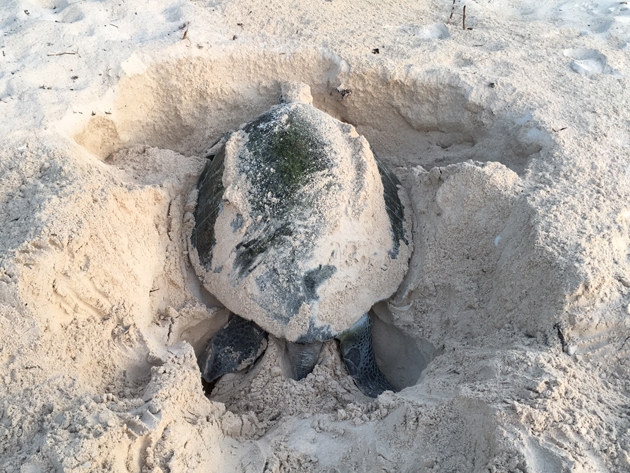Turtle conservation on Con Dao Island
Con Dao Island is currently implementing marine turtle conservation and is home to the largest population of natural sea turtles in Vietnam. Around April to October every year, visitors arriving on Con Dao Island have the opportunity to experience turtles laying eggs and baby turtles hatching.

Bay Canh Islet is dubbed "Con Dao’s most ecological islet" as it is separated from the vibrant world outside, home to pristine blue seas and colourful coral. This place is also the largest marine turtle conservation area in Vietnam.
The islet is located inside the Con Dao National Park, so visitors must apply for an entrance permit at the National Park on Con Son Island. Once holding a valid license, visitors can charter a boat to go to Bay Canh, or simply buy a local turtle tour and locals will cover all the work for permits.
Bay Canh is also a large mangrove forest reserve of Con Dao home to wild chickens, squirrels, butterflies and 24 species of mangrove plants.

The turtle's reproductive season is around April to October, peaking between July and September. Visitors can only stop at the island for 4-6 hours or stay overnight on Bay Canh Islet to experiences the sight of turtles laying eggs under the guidance of forest rangers. Depending on the tide, the time for turtles crawling onto the sand and laying eggs ranges from 10pm to midnight.
When mother turtles are on the shore digging holes to protect their precious eggs, forest guards will guide visitors to follow a detour and keep silent to avoid making the turtle mother panic and return to the sea.
Mother turtles will choose a fine sandy area near groves and use their forelegs to dig their nests, and then use their hind legs to dig a hole about 50-60 cm deep and 20 cm wide and begin laying eggs. Lit up by flashlight, visitors will see each round, white turtle egg be carefully placed into the hole. After filling the nests, sea turtles continue to use their forelegs to fill in the hole, remove their traces and camouflage their eggs.

A mother tortoise lays about 80 eggs on average, but there are also more than 200 eggs in Con Dao. After the mother turtles have left their nests, forest staff take eggs to the incubators. Eggs are incubated within 6 hours.
When bringing eggs to incubators, half of the eggs will be put in a hole with plenty of light, while the other half will be placed in others covered with a sunscreen above. This is to balance the "sex" of the hatchlings when hatches, as turtles’ sex can be adjusted by the action of light and temperature during incubation. About 45-60 days after being produced, baby turtles will hatch out of the eggs.


A mother turtle digs a hole before laying her eggs.
In Con Dao, there are many places where turtles lay eggs such as Cau, Tre Lon and Tai Islets, but most of them usually arrive on the big sandy beach of Bay Canh Islet to lay eggs.Bay Canh Islet is dubbed "Con Dao’s most ecological islet" as it is separated from the vibrant world outside, home to pristine blue seas and colourful coral. This place is also the largest marine turtle conservation area in Vietnam.
The islet is located inside the Con Dao National Park, so visitors must apply for an entrance permit at the National Park on Con Son Island. Once holding a valid license, visitors can charter a boat to go to Bay Canh, or simply buy a local turtle tour and locals will cover all the work for permits.
Bay Canh is also a large mangrove forest reserve of Con Dao home to wild chickens, squirrels, butterflies and 24 species of mangrove plants.

Mangroves of Bay Canh.
The turtle's reproductive season is around April to October, peaking between July and September. Visitors can only stop at the island for 4-6 hours or stay overnight on Bay Canh Islet to experiences the sight of turtles laying eggs under the guidance of forest rangers. Depending on the tide, the time for turtles crawling onto the sand and laying eggs ranges from 10pm to midnight.
When mother turtles are on the shore digging holes to protect their precious eggs, forest guards will guide visitors to follow a detour and keep silent to avoid making the turtle mother panic and return to the sea.
Mother turtles will choose a fine sandy area near groves and use their forelegs to dig their nests, and then use their hind legs to dig a hole about 50-60 cm deep and 20 cm wide and begin laying eggs. Lit up by flashlight, visitors will see each round, white turtle egg be carefully placed into the hole. After filling the nests, sea turtles continue to use their forelegs to fill in the hole, remove their traces and camouflage their eggs.

Turtle eggs.
A mother tortoise lays about 80 eggs on average, but there are also more than 200 eggs in Con Dao. After the mother turtles have left their nests, forest staff take eggs to the incubators. Eggs are incubated within 6 hours.
When bringing eggs to incubators, half of the eggs will be put in a hole with plenty of light, while the other half will be placed in others covered with a sunscreen above. This is to balance the "sex" of the hatchlings when hatches, as turtles’ sex can be adjusted by the action of light and temperature during incubation. About 45-60 days after being produced, baby turtles will hatch out of the eggs.

With a survival rate of 1/1000, sea turtles are listed in the Red Book of Vietnam, as well as around the world.

Leave your comment on this story